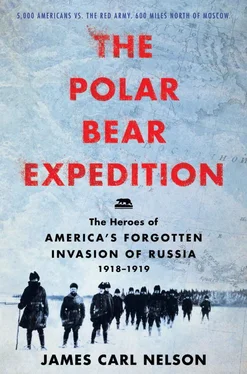One of them was Donald Carey. Though on August 30 he had written a cheery letter home saying that he had “not been sick and have been eating all I want,” by September 4 he had to eat his words. “Was weak and ill all day,” he wrote. “Despite this I had to help clean our quarters.”
Even as the ships carrying the sick and well men of the 339th were rounding the northern coast of Scandinavia with their intended destination being Murmansk, events were playing out that would see the convoy rerouted to the east—and urgently. Unknown to the men, Americans had already gone into action against Bolshevik forces south of the city of Archangel, and a polyglot force of Allies was fighting for its survival in the deep woods and swamps in the Russian interior.
In the first step toward intervention in Russia, Woodrow Wilson had answered the Allies’ pleas for help by agreeing to send the 5,800-ton cruiser Olympia to Murmansk. The ship, which had been Adm. George Dewey’s flagship during the Battle of Manila in the Spanish-American War, was quickly refitted at the Charleston Naval Yard and then sailed for England.
There, it refueled and then picked up the man who was to oversee the Allies’ actions in Russia, forty-nine-year-old British general Frederick Poole, who had been designated as the British military’s representative in Russia.
On May 24, the Olympia heaved to off Murmansk, which had been garrisoned by 130 British marines since March in an effort to meet the supposed German threat to the area. On June 8, an American contingent of 108 men landed in the city; though Murmansk was under control of the Bolsheviks, the landing was not contested, but indeed had been encouraged by Leon Trotsky, who was in a lather over the phantom German threat.
On June 23, a French warship arrived, carrying a token force of soldiers. By the end of June, the Allied force at Murmansk numbered more than 1,600, the largest portion being British veterans, some adorned with one or more wound chevrons earned on the Western Front. Two degress north of the Arctic Circle, Murmansk was bathed in midnight sun.
It wasn’t until late July, however, that Poole was ready to strike the Russian mainland, targeting Archangel, a port city some three hundred miles southeast, which had been operating under Bolshevik rule for several months. On July 30, a convoy of ships left Murmansk carrying five hundred French soldiers, one hundred British marines, and a force of fifty American seamen under command of Lt. Henry Floyd aboard the S.S. Stephens .
One of the ships carrying the French, the Amiral Aube , ran aground in the dense fog off the Kola Peninsula, but at first light the others reached the mouth of the wide Dvina River, which emptied into the White Sea. After reducing two batteries of Bolshevik artillery on Modyuski Island, the flotilla proceeded the twenty-five miles to Archangel.
Anti-Red forces in the city had been planning a coup to coincide with the pending arrival of Poole’s force, and even as the ships navigated the river on August 2 a bloodless local revolution put the city in the hands of the new Sovereign Government of Northern Russia.
The Bolsheviks, meanwhile, were in a panic, and they began looting the vast stockpile of Allied materiel, whose protection had been one of the main excuses for the intervention occurring in the first place. By boat and locomotive, they began shipping the stores south; some were moved by boat up the Dvina River, and others were hauled by rail toward the town of Obozerskaya, some one hundred miles south.
The haul was enormous: besides military and hospital equipment and medical supplies, the Bolsheviks made off with food stores, hardware of all kinds, jewelry, boats, and the rolling stock of the railroad. Even as the city was being cleaned out, refugees were flowing in from east, west, and south, as the Bolsheviks invested their villages and homes.
Arriving, too, was the small Allied contingent. Quickly, the American naval force of fifty men was split, with twenty-five sailors being assigned to the railway yard at Bakharitza, across the river from Archangel. There, Ens. Donald M. Hicks and his merry band of bluejackets went searching for adventure—and found it in an abandoned steam engine that still had some kick in it.
The sailors attached flatcars to the wood-burning locomotive and, armed with machine guns and protected by rows of sandbags, were soon rattling south in search of the Bolsheviks and their Allied booty.
Thirty miles down the track, near the village of Tundra, they had their first encounter with the Reds. Halting at a bridge that had been destroyed by the Bolsheviks, the sailors opened fire, but soon realized the sandbags offered scant protection from the enemy’s return fire—which was intense.
They found a more secure defensive position and remained there for almost a week before Hicks and another sailor returned to Archangel on August 10 with fifty-four Bolshevik prisoners in tow.
By then, the Allied force had been split. Hicks and the other sailors from the Olympia were put under the command of a British lieutenant colonel, Haselden, along with one hundred French soldiers, twenty-seven Poles, and thirty-five Russians, many of them deserters from the Russian Army who became part of the British-trained and -led Slavo-British Allied Legion, or S.B.A.L.
They would comprise Force B, while more British, French, and Russian troops plus the remaining twenty-five American sailors would become Force A. The plan, as devised by the British command, was for Force A to head down the railway to Obozerskaya while Force B would head 120 miles up the Dvina to the village of Siskoe, then head south toward Plesetskaya, a Bolshevik railway base about forty miles south of Obozerskaya.
At its grandest, the plan drawn by General Poole and his staff envisioned the quick taking of Obozerskaya and then a rapid movement toward Vologda, another three hundred miles south along the railway. Another mixed body of troops, called Force C, would steam for Kotlas, three hundred miles to the southeast. From Kotlas, the tiny river army would entrain almost three hundred miles farther to Viatka and make contact with that part of the Czech Legion supposedly moving—or trying to move—west.
The Czechs would then be led another five hundred miles west to Vologda, and so link with the Allied force there. Along the way, Poole’s men and the Czechs would rally “100,000 friendly Russians” to their cause, as he conveyed to one American official. From Vologda, one author would write sardonically, these tens of thousands of patriotic Russians and wandering Czechs would move “unopposed” yet another five hundred miles west to Petrograd, and from there move east and reconstruct the Eastern Front.
As Cudahy would note, “There was nothing lacking in the imagination of the plans of the Allied High Command, whatever else might be said about them.”
In reality, Force C quickly bogged down when confronted with Red gunboats and land batteries at Beresnik, 140 miles upriver from Archangel (as the crow flies). Ens. Donald Hicks and his contingent meanwhile found themselves also being towed forty miles up the wide, shallow, sluggish Dvina—characterized as northern Russia’s Mississippi River by many—to Siskoe, and then, with fuzzy maps and virtually no information about the countryside, they followed a road through deep forests, headed southwest for Plesetskaya.
Passing through Emetskoe, and encountering here and there locals who cheered the strange conglomeration of soldiers, Force B made the village of Tiogra on August 15. There, they learned that a group of 250 Red sailors were in the next town to the west, Seletskoe, and had with them seven machine guns, an armored car, and two pieces of field artillery.
Читать дальше








